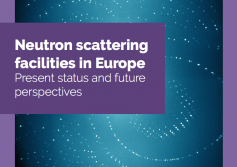Copyright 2012 neutronsources.org | All rights reserved. | Powered by FRM II | Imprint / Privacy Policy
European Landscape of Research Infrastructures: Neutron scattering facilities in Europe - Present status and future perspectives
Date: 30/06/2016
Source: esfri.eu

ESFRI Physical Sciences and Engineering Strategy Working Group – Neutron Landscape Group
ESFRI Scripta series will publish documents born out of special studies mandated by ESFRI to high level expert groups, when of general interest. This first volume reproduces the concluding report of an adhoc group mandated in 2014 by the Physical Science and Engineering Strategy Work Group (PSE SWG) of ESFRI, to develop a thorough analysis of the European Landscape of Research Infrastructures devoted to Neutron Scattering and Spectroscopy, and its evolution in the next decades. ESFRI felt the urgency of such analysis, since many reactor-based neutron sources will be dismissed in the next years due to national decisions, while the European Spallation Source (ESS) in Lund will be fully operative only in the mid or late 2020s. It was necessary to analyse at the appropriate level the implications in terms of capacity and capability of neutron science in Europe, both during the crossover period of national reactors with the ESS, and in the longer term.
This rationale led ESFRI to create the Neutron Landscape Group (NLG), co-chaired by Prof. Colin Carlile (former Director General of the ILL and of the ESS-Scandinavia) and Prof. Caterina Petrillo (now vice-chair of the ESS Council).
Some conclusions of the NLG report were published in the Landscape Analysis section of the Roadmap ESFRI 2016, published on 10th March 2016. Here we publish as ESFRI Scripta the full NGL report since it has the character of a reference book on the neutron research infrastructures with implications and scenarios of the possible strategies for Europe in this field.
The Neutron Landscape represents an analysis of the European RI system supporting science based on neutron scattering and spectroscopy. This reinforces the ability of the PSE SWG of ESFRI to adequately fulfil its mission of providing a thorough Landscape Analysis of the research infrastructures ecosystem beyond the ESFRI Projects and Landmarks. The Landscape Analysis and its projection in the next decades, taking into full account the lifecycle of the existing and planned research Infrastructures, forms a key part of the background for the evaluation of Projects and Landmarks.
ESFRI Scripta do not represent in any way the view or prioritization of ESFRI or of any Member State for commitments or future investments. ESFRI in no case acts as an advocate of specific potential future projects. The PSE SWG has reported about this publication to the ESFRI Forum on June 2016 and its Member Delegations have taken note of it.
Access the provisional version of the report here